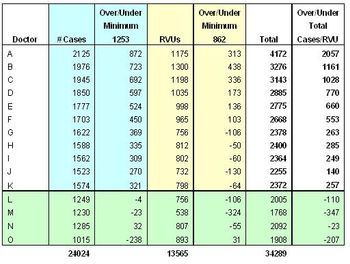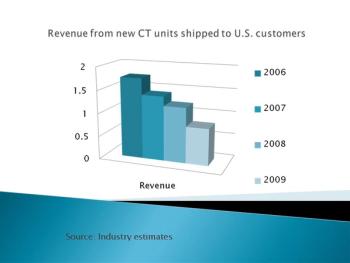
Physicians can improve coding decisions by better understanding needle-based and catheter-based thoracentesis techniques.
Because of all the attention currently focused on radiation dose, a California imaging bill addressing radiation exposure has the potential to spread like wildfire to other states. California is a state that doesn’t wait for others to address a problem, so it’s possible similar bills could pop up around the country. The bill has passed the California senate and is now in the California Assembly Appropriations Committee with a hearing set for Aug. 4. Sen. Alex Padilla (D-Pacoima) is lead sponsor of the bill.

Physicians can improve coding decisions by better understanding needle-based and catheter-based thoracentesis techniques.

Recruitment for radiologists has shifted from private radiology groups to hospitals and big teleradiology groups, according to national physician search firm Merritt Hawkins, an AMN Healthcare Company.

Not even two months have passed since a private equity firm snagged teleradiology provider Virtual Radiologic, but in that time the imaging industry has played host to several other such deals. The most recent was a bid by Hologic, announced earlier this week, to acquire privately held Sentinelle Medical. Others are Sonosite’s purchase of a different Canadian company, VisualSonics of Toronto, completed just a few days ago, and Covidien’s pending acquisition of ev3, a maker of interventional devices.

In a case that goes to the heart of privileging issues, six interventional radiologists associated with Radiological Associates of Sacramento have filed lawsuits against Sutter Health for refusing to allow them to perform procedures at Sutter facilities.

Virtual Radiologic, already a major player in the teleradiology field, aims to become a major player in the radiology IT space as well with the launch of a new suite of image management products.

Radiology groups pan call for FDA regulation of imaging dose; author defends position and urges more action by the specialty

Not everyone is convinced cumulative radiation dose exists, or even that repeat CT scans cause cancer.

Awareness can be a powerful tool. When 50 centers performing coronary CTA compared protocols, they found that some were exposing patients to 10 times the radiation dose others were.

Radiologists must get used to the idea of competing with nontraditional companies such as teleradiology provider Radisphere if they hope to survive, according to a radiology practice expert. In particular they must provide subspecialty coverage, otherwise it’s all too easy to replace them.

Assuming our hypothetical radiology practice reached consensus regarding a baseline compensation package, what would be the financial implications to physicians in the group? We begin with a practice profile.

A physician, who at the time was the principal doctor of a major medical clinic, once approached me about radiation dose issues and asked me to compare a chest x-ray to a chest and abdomen CT scan. I was prepared, having dealt with similar concerns expressed by other medical practitioners, and explained briefly how it can vary greatly and how the potential health hazards are weighed against the benefits. It was not the first time I had an inquiry about dose-saving techniques from the medical community or from patients. I started realizing how more and more the general public is being affected by media coverage and how the medical community should be able to react.

A new initiative by the American College of Radiology addresses growing tensions between hospitals and their contracted radiology groups, some of which have caused the relationship to end in a bitter breakup.

The first article in this series discussed why productivity-based compensation is controversial based on the various production levels in the group: the racehorses, plowhorses, and plodders. Once productivity-based compensation has passed the conceptual stage, the real work begins. And this phase, due to its potential complexity and the reality of potential salary adjustments, often represents the point at which the wheels fall off.

How would you feel if legislators in your state approved a law requiring a specific statement in certain types of radiology reports?

From Mike Graham, healthcare territory manager for Anthro, a vendor of digital workstation furniture:

A recent study from Massachusetts General Hospital finding that radiologists suffer from poor ergonomics in the reading room put a spotlight on a relatively common problem in radiology.

In response to a dramatic increase in the volume and cost of diagnostic imaging and other ancillary services furnished to Medicare patients in referring physicians’ offices, the Medicare Patient Advisory Commission is considering ways to rein in both.

A dramatic shift in R&D toward patient safety has taken place in the CT industry, a shift most clearly seen in efforts to reduce patient radiation dose. Iterative reconstruction algorithms are a prominent fixture at the ISCT meeting this year, as they and their future development are increasingly seen as providing the means to cut dose, while maintaining or even boosting image quality.

Fears that revenues last year from the sale of new CTs in the U.S. would slide to levels not seen in a long time proved to be well founded, as the industry suffered its worst year in more than a decade.

Much is known about dose reduction and adult patients, but what about kids? The literature is scant, but that doesn’t mean solutions don’t exist, according to a presenter at the International Society for Computed Tomography conference May 21.

Virtual Radiologic, one of the nation’s two publicly traded teleradiology companies, has agreed to be acquired by Providence Equity Partners, a private equity firm, for $17.25 per share in cash, the companies announced Tuesday.

A dramatic shift in R&D toward patient safety has taken place in the CT industry, a shift most clearly seen in efforts to reduce patient radiation dose. Iterative reconstruction algorithms are a prominent fixture at the ISCT meeting this year, as they and their future development are increasingly seen as providing the means to cut dose, while maintaining or even boosting image quality.

Fears that revenues last year from the sale of new CTs in the U.S. would slide to levels not seen in a long time proved to be well founded, as the industry suffered its worst year in more than a decade.

At best, productivity-based compensation is a hot topic; at worst, it is potentially the downfall of those promoting it-if not threatening to the very survival of a group. Are there groups compensating on a productivity-based model? Yes, but very few.

The landscape for hospital-based radiologists has shifted dramatically in the last couple of years. They’ll need to update their thinking if they hope to preserve their hospital contracts, and perhaps, a significant role in medicine, a pair of presenters said Sunday at the American Roentgen Ray Society meeting in San Diego.